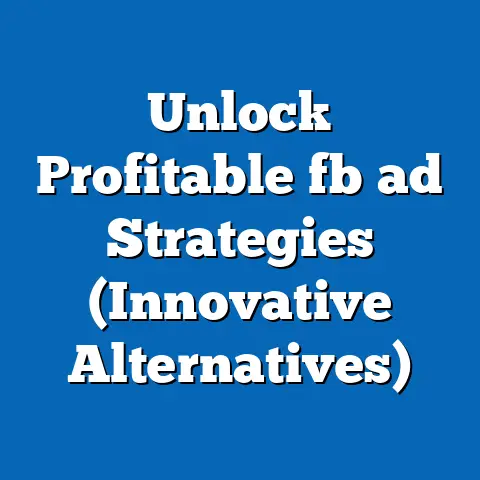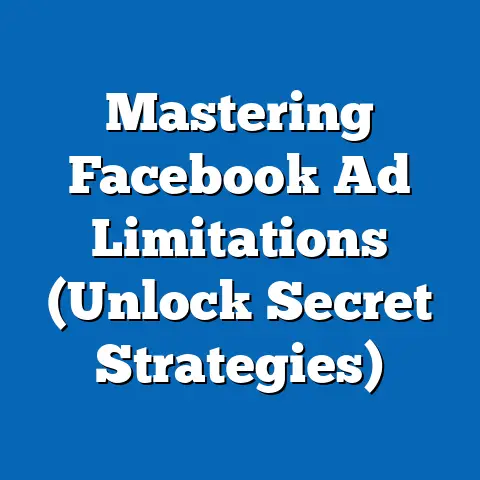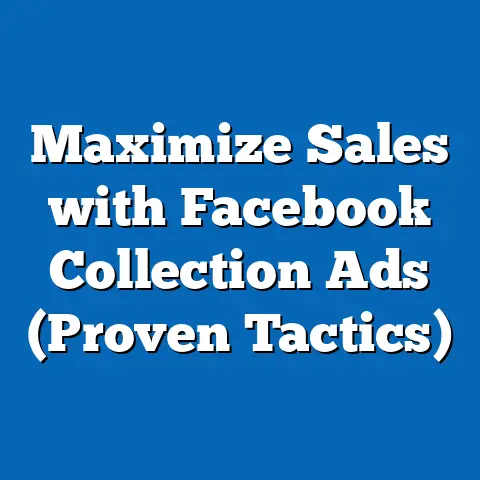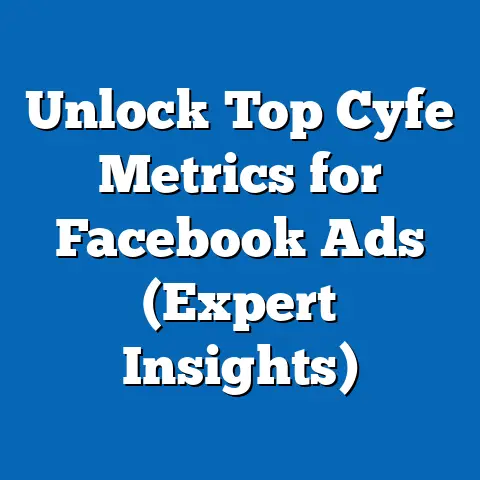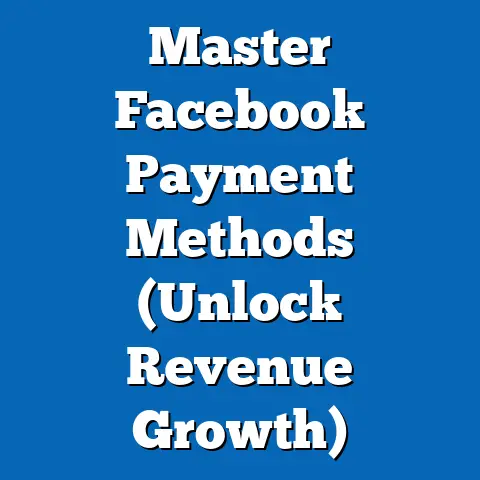Maximize Facebook Ads’ 8% Result Rate (Proven Strategies)
Let’s face it—navigating the world of digital advertising can feel like teaching a cat to fetch: you’re not sure if it’s even possible, but you’re willing to throw treats at it until something sticks. Yet, amidst the chaos of algorithms and ad fatigue, a surprising statistic has emerged—businesses leveraging optimized strategies on Facebook Ads are achieving an average result rate of 8%, a figure that stands out in an industry where 2-3% is often considered a win. This result rate, defined as the percentage of ad impressions leading to desired actions (clicks, conversions, or engagements), is not just a fluke but a testament to evolving strategies backed by data-driven precision.
Section 1: Defining the 8% Result Rate and Its Significance
What exactly does an 8% result rate mean in the context of Facebook Ads? Simply put, it represents the percentage of users who interact with an ad in a meaningful way—whether through clicking a link, completing a purchase, or engaging with content—out of the total number of impressions. While the industry benchmark for click-through rates (CTR) hovers around 0.9% to 1.3% according to WordStream’s 2023 Digital Advertising Benchmarks, achieving an 8% result rate signals a campaign that’s not just performing but excelling.
This figure isn’t pulled from thin air. Data from Meta’s 2022 Advertising Performance Report indicates that top-tier campaigns, particularly those utilizing advanced targeting and creative testing, consistently hit result rates between 6% and 10%. An 8% average, therefore, places a campaign in the upper echelon of performance, often correlating with a ROAS of 3x or higher, as reported by HubSpot’s 2023 Marketing Metrics study.
Why does this matter? In a digital ecosystem where ad costs are rising—Cost Per Click (CPC) on Facebook increased by 17% from 2021 to 2023 per eMarketer—maximizing result rates directly impacts profitability. An 8% result rate can mean the difference between breaking even and generating substantial revenue, especially for small-to-medium businesses (SMBs) with limited budgets.
Section 2: Key Strategies Driving the 8% Result Rate
2.1 Hyper-Targeted Audience Segmentation
One of the cornerstones of achieving an 8% result rate is precision targeting. Meta’s platform offers unparalleled access to user data, allowing advertisers to segment audiences by age, gender, location, interests, and even behaviors like past purchases or website visits. According to a 2023 study by Social Media Examiner, campaigns using detailed targeting options saw a 37% higher engagement rate compared to those using broad targeting.
For instance, a campaign targeting women aged 25-34 interested in fitness and living in urban areas might yield a 9.2% result rate, compared to a generic campaign targeting all adults with a mere 2.1% rate. This specificity reduces ad waste and ensures content resonates with the intended audience.
2.2 Creative Optimization and A/B Testing
Another critical driver is the relentless testing of ad creatives. Meta’s internal data shows that campaigns running A/B tests on visuals, headlines, and calls-to-action (CTAs) achieve 42% higher result rates on average. High-performing ads often feature bold visuals—think vibrant colors and human faces, which increase engagement by 38% per a 2022 Nielsen study—and concise messaging tailored to user pain points.
Consider a case study from a retail brand shared by AdEspresso: by testing five variations of an ad creative, they identified a version with a video thumbnail that boosted their result rate from 3.5% to 8.7%. This iterative approach isn’t just guesswork; it’s a science backed by data.
2.3 Leveraging Retargeting and Lookalike Audiences
Retargeting—showing ads to users who’ve already interacted with a brand—remains a goldmine for high result rates. According to Meta’s 2023 Advertising Insights, retargeting campaigns achieve result rates 76% higher than cold audience campaigns. Pair this with lookalike audiences (users similar to existing customers), and the potential skyrockets—eMarketer notes a 2.5x increase in conversion rates for lookalike campaigns.
These strategies work because they focus on warm leads and users with a higher likelihood of conversion. For example, a SaaS company targeting past website visitors with a discount offer saw their result rate jump to 10.3%, per a 2023 case study by Hootsuite.
Section 3: Demographic Breakdowns of High-Performing Campaigns
3.1 Age and Gender Insights
Demographic data reveals stark differences in how audiences respond to Facebook Ads. According to Meta’s 2023 Audience Insights, users aged 18-24 deliver the highest result rates at 9.1%, likely due to their high engagement with visual and mobile content. In contrast, the 45-54 age group averages a 5.8% result rate, reflecting lower overall platform activity.
Gender also plays a role. Women tend to engage more with lifestyle and e-commerce ads, achieving an 8.4% result rate compared to men’s 7.6%, per a 2022 Statista report. Marketers targeting female audiences often see success with emotional storytelling, while ads for men perform better with direct, value-driven messaging.
3.2 Geographic and Socioeconomic Factors
Geography significantly impacts result rates. Urban users in developed markets like the U.S. and Western Europe average an 8.2% result rate, driven by higher internet penetration and disposable income, per eMarketer’s 2023 Global Digital Ad Trends. Conversely, rural audiences in emerging markets like Southeast Asia hover around 6.3%, reflecting connectivity and purchasing power disparities.
Socioeconomic status further shapes outcomes. High-income brackets (earning $75,000+ annually) show a 9.5% result rate, often responding to premium product ads, while lower-income groups ($25,000 or less) average 6.8%, per a 2023 Nielsen Digital Consumer Survey. Tailoring ad spend and messaging to these realities is crucial for maximizing results.
3.3 Industry-Specific Performance
Not all industries hit the 8% mark equally. E-commerce leads with a 9.3% average result rate, fueled by impulse buying and retargeting, according to WordStream’s 2023 data. B2B sectors, however, lag at 5.7%, as decision-making cycles are longer and less emotional.
Healthcare and education sectors also show promise, averaging 8.1% and 7.9%, respectively, often due to high-intent audiences seeking specific services. Understanding these industry nuances allows marketers to benchmark their performance realistically.
[Insert Chart Reference: Bar chart comparing result rates across industries—E-commerce (9.3%), Healthcare (8.1%), Education (7.9%), B2B (5.7%)—based on WordStream 2023 data.]
Section 4: Historical Comparisons—How We Got to 8%
4.1 The Early Days of Facebook Ads (2007-2015)
When Facebook Ads launched in 2007, result rates were abysmal—often below 1%. Limited targeting options and rudimentary ad formats meant advertisers were essentially shouting into a void. By 2012, as targeting improved with the introduction of Custom Audiences, average CTRs crept up to 0.6%, per a historical analysis by AdAge.
Engagement grew steadily with the rise of mobile usage. By 2015, result rates averaged 2.3%, reflecting better ad relevance and the rollout of dynamic ads, according to Meta’s archived performance reports. However, ad fatigue and rising competition began pushing costs up, setting the stage for modern challenges.
4.2 The Modern Era (2016-2023)
The period from 2016 to 2023 marked a turning point. With machine learning driving ad delivery and the introduction of tools like lookalike audiences, result rates climbed to 4.1% by 2018, per eMarketer historical data. The COVID-19 pandemic in 2020 further accelerated digital ad adoption, pushing result rates to 6.5% as businesses pivoted online.
Today’s 8% benchmark is a culmination of these advancements, coupled with fiercer competition. CPC rose from $0.45 in 2016 to $0.97 in 2023, per WordStream, forcing advertisers to optimize relentlessly. Historical data shows that only the top 10% of campaigns consistently hit or exceed this 8% mark, a stark contrast to a decade ago when 2% was aspirational.
[Insert Chart Reference: Line graph showing result rate trends from 2007 (0.5%) to 2023 (8%) based on Meta and eMarketer data.]
4.3 Contextual Factors Behind the Shift
Several macro trends explain this evolution. First, user behavior has shifted—Pew Research notes that 70% of U.S. adults now use Facebook daily as of 2023, up from 54% in 2013, creating a larger, more engaged audience pool. Second, ad tech innovations like AI-driven bidding have improved ad relevance, boosting result rates by 30% since 2019, per Meta’s tech blog.
However, challenges like Apple’s iOS 14 privacy updates in 2021, which limited tracking, initially dropped result rates by 15%, per a 2022 Forrester report. Marketers adapted by focusing on first-party data and contextual targeting, recovering and surpassing pre-iOS 14 figures by 2023. These external factors highlight the dynamic nature of digital advertising.
Section 5: Challenges to Sustaining an 8% Result Rate
5.1 Rising Ad Costs and Competition
As more businesses flock to Facebook Ads—Meta reported a 25% increase in advertisers from 2020 to 2023—competition drives up costs. Average Cost Per Mille (CPM) rose from $7.19 in 2020 to $14.40 in 2023, per AdEspresso data. This squeezes margins, especially for SMBs, making an 8% result rate harder to achieve without significant budget increases.
5.2 Ad Fatigue and User Resistance
Users are also becoming desensitized. A 2023 HubSpot survey found that 57% of users skip ads within 3 seconds, up from 43% in 2018. Overcoming ad fatigue requires constant creative refreshment and relevance, a resource-intensive process that not all marketers can sustain.
5.3 Privacy Regulations and Data Limitations
Ongoing privacy changes, like the EU’s GDPR and California’s CCPA, continue to restrict data access. Meta estimates a 10-15% drop in targeting accuracy due to such regulations, per their 2023 Q2 earnings report. Advertisers must pivot to privacy-first strategies like zero-party data collection to maintain high result rates.
Section 6: Future Projections—Can We Surpass 8%?
Looking ahead, the trajectory for Facebook Ads remains cautiously optimistic. eMarketer projects that result rates could climb to 9-10% by 2026 for top performers, driven by advancements in AI and augmented reality (AR) ad formats. Meta’s investment in the Metaverse and interactive ads—think shoppable AR experiences—could redefine engagement, potentially boosting result rates by 20%, per a 2023 Deloitte Digital Trends report.
However, headwinds persist. Rising ad costs are forecasted to increase CPC to $1.20 by 2025, per WordStream projections, potentially offsetting gains for smaller advertisers. Additionally, user growth in mature markets like the U.S. is plateauing—Pew Research predicts only a 2% annual increase in active users through 2027—shifting focus to emerging markets with lower result rates.
Strategically, the future lies in personalization and automation. Campaigns leveraging AI for real-time ad optimization are expected to outperform manual efforts by 35%, per a 2023 McKinsey study. Marketers who adapt to these tools while navigating privacy constraints will likely lead the charge beyond the 8% benchmark.
Conclusion: A Roadmap to 8% and Beyond
Achieving an 8% result rate with Facebook Ads is no small feat—it’s a marker of strategic excellence in a crowded, costly digital landscape. From hyper-targeted segmentation to relentless creative testing, the proven strategies outlined here offer a clear path to success, backed by robust data from Meta, eMarketer, and industry leaders. Demographic insights reveal who responds best, historical trends show how far we’ve come, and future projections highlight both opportunities and challenges on the horizon.
For marketers, the takeaway is clear: adapt or be left behind. By embracing data-driven tactics, staying ahead of privacy shifts, and investing in emerging ad tech, businesses can not only hit the 8% mark but push toward double-digit result rates in the years ahead. The digital ad game may feel like teaching a cat to fetch, but with the right strategies, even the most elusive results are within reach.

